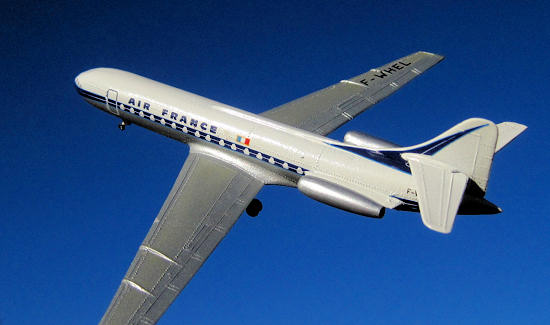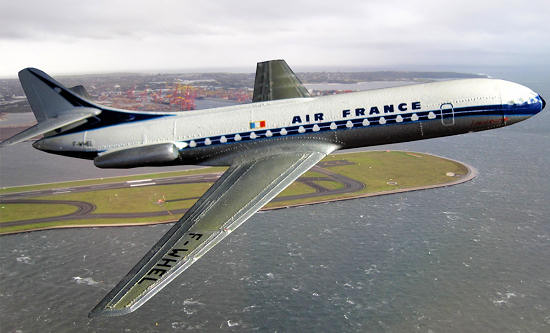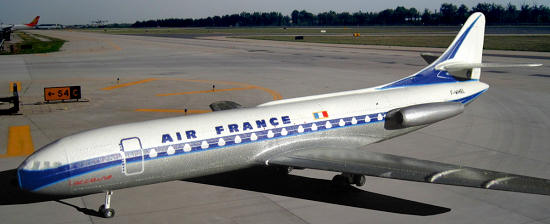
Heller 1/200 Sud-Aviation Caravelle
| KIT #: | ? |
| PRICE: | $ |
| DECALS: | One option |
| REVIEWER: | Richard F |
| NOTES: |

| HISTORY |
This elegant airliner was designed to a 1951 French requirement for a
plane that could carry 55-65 passengers 2,000 km at 600 km/h.
 It doesn't sound very dramatic today, and even in 1951 it wasn't particularly
amazing. The turboprop Vickers Viscount could carry 75 people over that range,
and only a little bit slower. The legendary Super Constellation could carry 95
people four times as far at 550 km/h.
It doesn't sound very dramatic today, and even in 1951 it wasn't particularly
amazing. The turboprop Vickers Viscount could carry 75 people over that range,
and only a little bit slower. The legendary Super Constellation could carry 95
people four times as far at 550 km/h.
So what was so special about the Caravelle?
By placing its two jet engines at the end of the fuselage, Sud-Aviation came up
a sleek design that gave unprecedented cabin quietness. It also gave clean wing
airflow without disruption by nacelles or pylons. Flaps and slats could run the
entire span of the wing. There were no engine blast concerns on the trailing
edge. The simple design also gave improved airflow at low speeds and enabled
lower takeoff and approach speeds, which reduced airstrip length requirements
and kept wing structures light. Having the engines high up on the rear fuselage
reduced the risk of foreign object damage and gave better ground clearance,
making the aircraft more accessible to baggage handlers and passengers.
This was a winning design, and when it was released in 1952, it was the first
airliner to use that configuration. The Caravelle first flew in 1955.
Later aircraft designs to adopt the configuration included the BAC1-11, DC-9
(designed in co-operation with Sud-Aviation), Trident, VC-10, 727, Tristar,
Tu-134 and -154, Il-62, Yak-40, and of course, numerous business jets starting
with the Lear 23.
 Heller's little kit provides markings for F-WHEL "Lorraine". On 27 July 1959,
this jet flew the Caravelle's first Paris-London revenue flight for Air France,
under its earlier registration of F-BHRB. It was later upgraded to Caravelle III
standard, gaining more powerful engines.
Heller's little kit provides markings for F-WHEL "Lorraine". On 27 July 1959,
this jet flew the Caravelle's first Paris-London revenue flight for Air France,
under its earlier registration of F-BHRB. It was later upgraded to Caravelle III
standard, gaining more powerful engines.
"Lorraine" flew for Air France until December 1977, completing 18 years of
service. It was broken up in October the following year.
There were 282 Caravelles built across 9 main versions. The last version, the
"Super Caravelle", was stretched to carry 140 passengers. A few flew as VIP
transports in the armed forces of France, Sweden, Argentina and the Central
African Republic.
Over the years, at least 11 Caravelles crashed. Almost all these crashes were
devastating, killing all or almost all the people on board. Most of the
accidents were attributed to pilot error.
The last Caravelle reportedly retired in 2005 - fifty years after the type's
first flight.
| THE KIT |
 This is a very basic kit. Some modelers describe it as a toy, but I
think it is a real kit that an average modeler can turn into a decent replica.
It is moulded in that classic Heller silvery plastic that you don't see much
these days.
This is a very basic kit. Some modelers describe it as a toy, but I
think it is a real kit that an average modeler can turn into a decent replica.
It is moulded in that classic Heller silvery plastic that you don't see much
these days.
It has massively over-scale rivet detail. But generally, it's actually quite
nice for such a cheap and small little kit.
| CONSTRUCTION |
A bit of nose weight is all you need before glueing this plane
together. There are no fuselage windows and no need for interior detail or
painting. The cockpit windows are simply holes in the plastic. I filled these.
I left all the overscale rivet and panel line detail in place - I just like it
like that!
The whole plane goes together in minutes. Fit is not perfect. What would you
expect from something like this? A bit of sanding is all you need, and it is
such a small kit that this doesn't take long. The worst area was on top of the
fuselage, just behind the nose.
| COLORS & MARKINGS |
 I used spray cans on this model. Heaven only knows why! Gloss white
on top and a Testors aluminium on the bottom. I sprayed yellow on the center
parts of the wings first, before spraying the aluminium over the top. I had read
that this would give the effect of a different shade of aluminium. I don't think
it was very successful, and these days there are plenty of better ways to
achieve that effect.
I used spray cans on this model. Heaven only knows why! Gloss white
on top and a Testors aluminium on the bottom. I sprayed yellow on the center
parts of the wings first, before spraying the aluminium over the top. I had read
that this would give the effect of a different shade of aluminium. I don't think
it was very successful, and these days there are plenty of better ways to
achieve that effect.
I filled and painted in the cockpit windows rather than leave them open.
The decals were good - they went on easily and have stayed in good condition for
many years.
| CONCLUSIONS |
If you like 1/200 airliners and you want a Caravelle then this is
your only choice (I think). The aircraft is available in other scales - 1/100
and possibly 1/144.
But if you like the small scale, or you just want a very quick build of a nice
looking aircraft, you can't really go past this little kit. I enjoy having it on
my shelf next to my other 1/200 aircraft.
| REFERENCES |
http://en.wikipedia.org/wiki/Sud_Aviation_Caravelle
http://www.airliner-pics.com/caravelle/cn1-50.htm
And a picture here:
http://www.airliner-pics.com/caravelle/cn002.htm
Richard F
July 2011
If you would like your product reviewed fairly and fairly quickly, please contact the editor or see other details in the Note to Contributors.